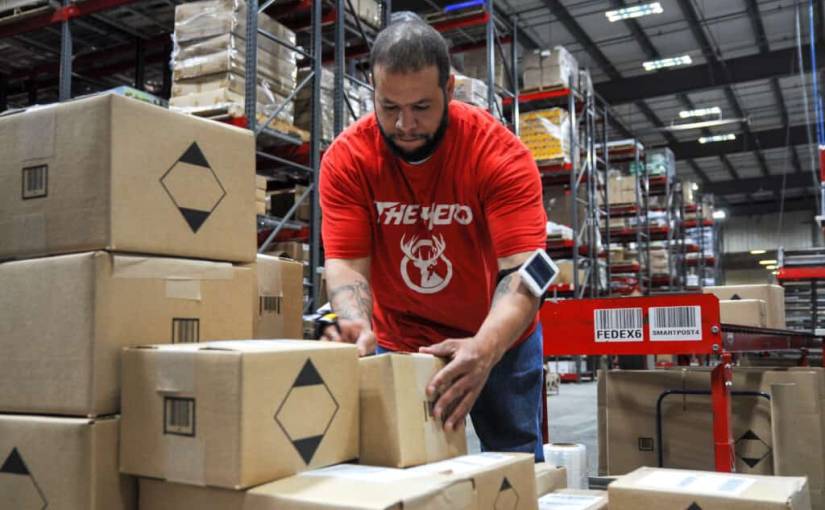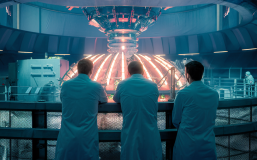Companies have long been looking to uncover the “Warehouse of Tomorrow” to solve all of today’s problems — from labor shortages and capacity crunches to new usage and reliable fulfillment. The approach of building a single location that can serve as a factory, distribution center, and operational HQ remains the dream, but the reality is starting to rear its head.
If the warehouse of tomorrow is potentially around the corner, the investment will soon flow. To get that right and not waste capital or time, companies should follow guidelines set by other emerging technologies, especially in the world of IoT.
Define Your ‘Tomorrow’
The warehouse of tomorrow is a pointed look to the future of warehousing and distribution, where companies design each location with an emphasis on connectivity and automation that make promises of improved efficiency and productivity during storage and fulfillment.
At its core, this is a modernization effort. The chief difference between future-proofing a warehouse and tackling most other infrastructure projects — especially for small and mid-sized brands — is the scale of operations. Warehouses tend to receive freight in large quantities. Then, staff breaks down these containers to store individual units or pallets. If parts are received instead, the warehouse stores these and has space for final assembly.
After customers make orders, workers will pick and pack stored products to fill these orders. Automated tools such as robotic arms and conveyors can eliminate some of the human element here. After packing, workers or robotics will apply shipping labels and move goods to staging areas where the carrier’s trailers are waiting. These trailers must be scheduled based on specific order volumes and relationships with the shipper, securing the capacity to move orders and ensuring that dock locations aren’t double-booked.
Every point in this process generates substantial data, has significant risk, and requires the proceeding steps to be executed on time and accurately. It’s a complex dance, and the focus on “tomorrow” is about leveraging sensors and AI to keep processes flowing. It builds a competitive advantage by improving forecast reliability, ensuring order accuracy, and quickly adapting to any economic change.
7 Rules to Guide Your Warehouse of Tomorrow
Building the warehouse of tomorrow requires a focus on both physical infrastructure and the devices and platforms powering how people work within the warehouse. A conveyor only improves order management and fulfillment speed when installed properly, and warehouse systems move the correct order down at the right time. Your warehouse of tomorrow is a cyborg, which means incorporating the latest tech while protecting those organic squishy bits.
1. Flexibility First
The warehouse of tomorrow should be designed with flexibility in mind, allowing for easy reconfiguration and adaptation to changing business needs. That means building to future-proof your operations and ensure that new technology can be implemented with as few barriers as possible.
IoT devices and platforms should provide guidance here. That means looking for tools and services that rely on common standards. Supporting EDIs and APIs needs to be a “must” on your list so you can utilize and customize new options. Consider placing sensors in areas where they’re easily accessible to allow for upgrades or repairs. The entire warehouse should have fast connectivity, and moving to more cloud platforms can give you a better chance at the long-term viability of tools.
Modular designs in racking and layout should also be considered. Part of this is because it makes repairs and maintenance easy, while the other side of the coin is that this enables rapid changes if you need to re-slot goods or adjust bays for new products.
2. Automation Has a Heart
Automation and machine learning technology should be integrated throughout the warehouse, especially for inventory management, order fulfillment, and tracking services. Tracking here covers every SKU and part in your inventory and monitoring teams to look for ways to improve efficiency and reduce physical demands on humans.
The warehouse of tomorrow will have people running the show. We hope to see that people are continually treated better and have their pressures reduced. Instead of needing to run across a warehouse for hours on end, they should be utilized for areas where you need discretion, complex decision-making, or a human touch.
The “rule” to guide you here is that automation is a helper at heart. You want automated decisions designed to improve business outcomes and workers’ jobs. Integrating advanced scanners on conveyors and at packing stations can quickly double-check order accuracy. Those gains are valuable; you can avoid putting them at risk by not trying to eke out more efficiency immediately after. Solving an issue but requiring a human to rush elsewhere goes against this heart.
3. Analytics Are the Brains, Whether Hands Are Human or Machine
The use of data and analytics should be included in all aspects of the warehouse, from inventory management to forecasting demand and planning for the future. There are a lot of decisions that can be automated, especially when using an immense amount of data. Let your smart warehouse management system (WMS) do this lifting for you.
The warehouse of the future will rely on WMS analytics to monitor inbound goods, current stock, current orders, and historical trends. From there, it’ll decide how much labor is needed for a shift, where goods should be stored, how orders are picked, and scheduling carriers to pick up orders. An ultimate goal is an inventory balancing across every warehouse, while the WMS acts as a central brain.
Companies will need to train these brains to ensure decisions are proper continually. Setting futuristic warehouses apart here is the inclusion of human-focused metrics where people are involved. Labor management modules will make decisions based on the existing workforce and immediate needs.
Say you normally experience an uptick in orders in July because you sell more warm-weather items. A smart system will know to scale up shift staff beforehand, remembering to make that increase even if schedules come out in June before your orders rise. The “tomorrow” aspect comes from the ability to look outside at broader trends and decide to increase stock levels and team members after an exceptionally warm May so that people and goods are in place when orders skyrocket in early June.
4. Efficiency Includes Energy
The warehouse of tomorrow should prioritize sustainability and energy efficiency, tracking renewable energy sources and usage throughout the supply chain. Modern consumers already want businesses to make eco-friendly decisions. According to recent studies, the problem is that many people are confused about sustainability promises. There’s also increased coverage of areas where some promises fall short.
The warehouse of tomorrow will need advanced sensors and data capabilities to monitor and report its electricity usage. This should be paired with understanding how the company buys or generates electricity and what renewable rates While warehouses are but one part of the overall sustainability efforts a company will enact, each should be reporting this data so a central hub can collect and report.
Warehouses can be the biggest consumption point for electricity that a company may own. This makes them a natural place to enable smart tracking and try out multiple eco-friendly efforts. Warehouse systems also interact with carriers, manufacturers, and other partners. Their centrality also puts the WMS as the most likely place to gather environmental data from upstream and downstream partners, generating a robust report that is factual and can be trusted by consumers.
5. Ergonomics Must Evolve
The safety and well-being of workers should be a top priority, with ample space for movement and ergonomic design to prevent injuries. A well-run warehouse is already an amazing example of this. You may find extra-wide aisles to ensure forklifts have plenty of room, while one-way signs limit the chance of accidents. Modern carts are easier to maneuver, and there are plenty of robots now available to follow pickers around the warehouse to make moving items that much easier.
The shift in the warehouse of tomorrow will come with greater attention paid to immediate ergonomics. Instead of relying on factory settings for chosen robotics, they’ll adapt to how they’re used. Assistants will know that they can be on the heels of a picker when SKUs are light but move further back when a bulky item is on the floor and needs more room for scanning and placing on the cart.
Expect more units to assist with lifting tasks while automated racking moves bins to the correct height for someone to grab effortlessly. An exciting option for tomorrow’s warehouse will be seeing bins adjust to the specific height of each picker, minimizing strain wherever possible.
6. Enshrine the Importance of Customer Communication
Collaboration and communication should be emphasized, with systems in place to facilitate easy communication and coordination between different teams and departments. The warehouse of tomorrow should be designed to provide the highest possible level of customer satisfaction, with efficient and accurate order fulfillment and a focus on providing a seamless customer experience.
The big work here will be on the backend for the brands’ customers know. Buyers won’t get their eyes in the warehouse, but they will get more useful information. That means automated updates for things like shipping when the notice is reliable. Gone will be the days of getting a “your item has shipped” email only to click through and see that the company created a shipping label, but the carrier hasn’t received it yet.
With the way the covid pandemic upended supply chains, companies should also expect to deliver more useful delay-related emails. The warehouse serves as a core place to generate customer delay communications because it houses the relevant data. Marketing and customer care services should integrate directly so that a warehouse notice includes the reasoning behind the delay, and this is shared with the buyer in an appropriate fashion.
7. Make Room for Tomorrow’s Tomorrow
The warehouse of tomorrow should be built with scalability in mind, allowing for easy expansion as the business grows. Flexibility and automation help an operation adapt in the here and now. But future planning (and especially future-proofing) requires one eye always to remain looking at the horizon.
Modular construction developments can help ensure a warehouse is physically able to expand with ease. 3PLs and warehouse service companies should be investing in space long before current warehouses fill to capacity. There should always be a plan to develop more room to grow.
The future twist is that growth requires flexibility in business models. One company’s warehouse may scale too large for sales. However, a smart, AI-driven WMS could make it simple for that company to turn part of its warehouse into a facility to process another company’s orders. Warehouses of the future will need adaptability to run more than one business model because sales naturally fluctuate and markets change.
When the warehouse can run multiple business operations, it becomes a potential revenue center. For businesses thinking about what the future holds, it’s often a good idea to enable additional revenue streams and create options that can survive downturns in one sector.
Featured Image Credit: Provided by the Author; Pexels Thank you!


















